
Education outcomes
 Education outcomes
Education outcomes
Southampton has a total of 75 schools and academies including 55 Primary Phase Schools, 12 Secondary and 8 Special Schools or Pupil Referral Units. Just under 34,000 pupils are educated across these 75 settings within Southampton schools. The outcomes reported below are for local authority maintained schools which includes maintained schools and academies but excludes independent schools, hospital schools, pupil referral units and alternative provision.
Early Years Foundation Stage Profile
The Early Years Foundation Stage Profile (EYFSP) is completed for pupils at the end of Reception. The EYFSP has 7 Areas of Learning (3 Prime Areas and 4 Specific Areas) and 17 Early Learning Goals. Pupils are teacher assessed as Emerging, Expected and Exceeding against each of the Early Learning Goals.
In response to the Coronavirus pandemic the Department for Education (DfE) cancelled the collection of EYFSP outcomes in 2020 and 2021. An updated EYFSP was completed for the first time in 2022.
A pupil achieving at least the expected level in the Early Learning Goals (ELG) within the three prime areas of learning (Communication and Language, Physical Development and Personal, Social and Emotional Development) and within Literacy and Numeracy is classed as having "a good level of development”. In 2022, 61.8% of pupils in Southampton achieved a Good Level of Development which was 3.4% below the national average of 65.2%. Southampton’s performance achieved a rank position of 129th in 2022 out of 152 Local Authorities. As an updated EYFSP was completed for the first time in 2022 trend data is currently not available.
Phonics
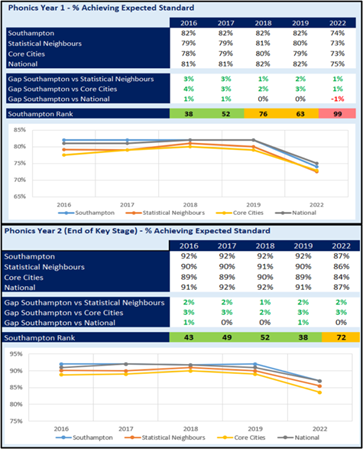 Pupils complete a Phonics screening check at the end of Year 1 where they achieve a score out of 40. A score of 32 or more is required for pupils to achieve the required standard of Phonics decoding. Pupils who do not achieve a score of 32 or more at the end of Year 1 resit the check at the end of Year 2 along with any pupils who did not previously complete the check at the end of Year 1 (e.g. pupils new to the country).
Pupils complete a Phonics screening check at the end of Year 1 where they achieve a score out of 40. A score of 32 or more is required for pupils to achieve the required standard of Phonics decoding. Pupils who do not achieve a score of 32 or more at the end of Year 1 resit the check at the end of Year 2 along with any pupils who did not previously complete the check at the end of Year 1 (e.g. pupils new to the country).
In response to the Coronavirus pandemic the Department for Education introduced an interim approach to the phonics screening check for 2020 and 2021. The DfE did not publish any Phonics outcomes for the two years affected by the Coronavirus pandemic.
In 2022, 74% of Southampton’s Year 1 pupils achieved the required standard in Phonics, which is 1% below the National average of 75%. Southampton’s performance achieved a joint rank position of 99th, with 20 other Local Authorities out of 150.
In 2022, 87% of Southampton’s pupils achieved the required standard in Phonics at the end of Year 2, which is in-line with the National average of 87%. Southampton achieved a joint rank position of 72nd, with 20 other Local Authorities out of 150.
Key Stage 1
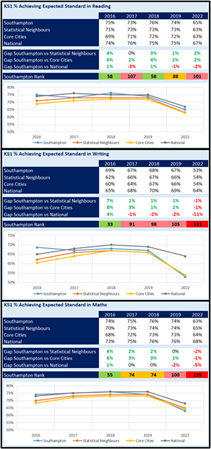 At the end of Year 2 pupils reach the end of Key Stage 1 (KS1) and are teacher assessed in Reading, Writing and Maths. In each subject pupils are awarded an outcome that identifies if they are working below the expected standard, working at the expected standard or working at a greater depth within the expected standard.
At the end of Year 2 pupils reach the end of Key Stage 1 (KS1) and are teacher assessed in Reading, Writing and Maths. In each subject pupils are awarded an outcome that identifies if they are working below the expected standard, working at the expected standard or working at a greater depth within the expected standard.
In response to the Coronavirus pandemic the Department for Education cancelled the collection of KS1 outcomes in 2020 and 2021.
In 2022, 65% of Southampton pupils were working at the expected standard in Reading, this was 2% below the National average (67%), ranking Southampton a joint 101st with 13 other Local Authorities out of a total of 150 Local Authorities. 14% of Southampton pupils were working at a greater depth within the expected standard, this was 4% below the National average (18%), ranking Southampton joint 124th with 14 other Local Authorities out of a total of 150 Local Authorities.
53% of Southampton pupils were working at the expected standard in Writing at the end of KS1 in 2022. This was 11% below the National average (64%), ranking Southampton joint 131st with 6 other Local Authorities out of a total of 150 Local Authorities. 6% of Southampton pupils were working at a greater depth within the expected standard, this was 4% below the National average (10%), ranking Southampton a joint 101st with 24 other Local Authorities out of a total of 150 Local Authorities.
In 2022, 63% of Southampton pupils were working at the expected standard in Maths, this was 5% below the National average (68%), ranking Southampton a joint 139th with 6 other Local Authorities out of a total of 150 Local Authorities. 12% of Southampton pupils were working at a greater depth within the expected standard, this was 3% below the National average (15%), ranking Southampton joint 122nd with 12 other Local Authorities out of a total of 150 Local Authorities.
Key Stage 2
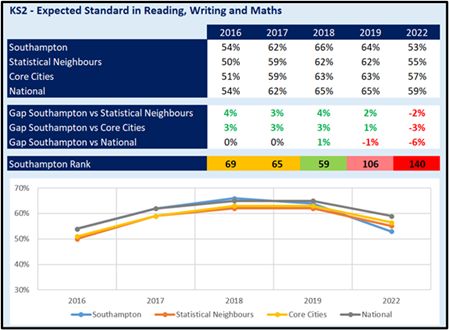 At the end of Year 6 pupils reach the end of Key Stage 2 (KS2) and are teacher assessed in Writing and tested in Reading and Maths. In each subject, pupils are awarded an outcome that identifies if they are working below the expected standard, working at the expected standard or working at a higher standard. The proportion of pupils that have achieved the expected standard across Reading, Writing and Maths combined is one of the main indicators at the end of KS2. There is also a focus on the progress pupils have made between KS1 and KS2. Progress is calculated separately for Reading, Writing and Maths with a score of 0 indicating similar progress to pupils nationally.
At the end of Year 6 pupils reach the end of Key Stage 2 (KS2) and are teacher assessed in Writing and tested in Reading and Maths. In each subject, pupils are awarded an outcome that identifies if they are working below the expected standard, working at the expected standard or working at a higher standard. The proportion of pupils that have achieved the expected standard across Reading, Writing and Maths combined is one of the main indicators at the end of KS2. There is also a focus on the progress pupils have made between KS1 and KS2. Progress is calculated separately for Reading, Writing and Maths with a score of 0 indicating similar progress to pupils nationally.
In response to the Coronavirus pandemic the Department for Education cancelled the collection of KS2 outcomes in 2020 and 2021.
In 2022, 53% of Southampton pupils achieved the expected standard in Reading, Writing and Maths which was 6% below the National performance of 66%. Southampton’s 2022 KS2 cohort achieved a rank position of 140th out of a total of 150 Local Authorities. 4% of Southampton pupils achieved the Higher Standard in Reading, Writing and Maths; 3% below the national average (7%) for this indicator, ranking Southampton 134th out of 150 Local Authorities.
Southampton’s KS2 progress score in Reading for 2022 was -0.23, a gap of 0.26 below the National average (0.04), ranking Southampton 105th out of 150 Local Authorities. Southampton’s KS2 progress score in Writing for 2022 was -1.42, a gap of 0-1.46 below the National average (0.05), ranking Southampton 147th out of 150 Local Authorities. Southampton’s KS2 progress score in Maths for 2019 was -0.42, a gap of -0.45 below the National average (0.04), ranking Southampton 113th out of 150 Local Authorities.
Key Stage 4
At the end of Year 11 pupils reach the end of Key Stage 4 (KS4). The KS4 accountability of Attainment 8 and Progress 8 was introduced in 2016. In 2017, new, reformed English and Maths GCSEs were first examined and a new grading of 9-1 was introduced, with 9 being the highest grade. In 2018, reformed English Baccalaureate GCSEs and a number of other key subjects were first examined using the 9-1 grading. In 2019 further reformed GCSE qualifications were introduced on the 9-1 grade scale. For the first time in 2020 all GCSEs had been converted to a scale of 9-1 with no unreformed GCSEs graded A*-G remaining. Consequently, any trend comparisons made between 2016 and 2020 results for the key headline performance measures must be treated with caution.
In response to the Coronavirus pandemic the DfE implemented alternative arrangements in 2020 and 2021 at Key Stage 4. Results during this period are therefore not comparable to other.
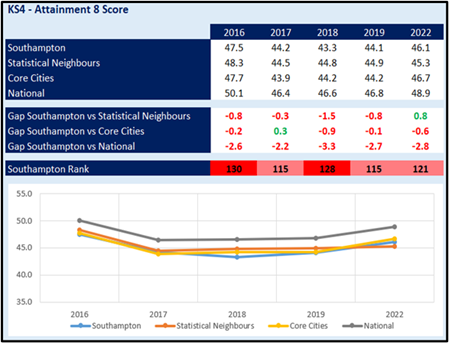 In 2022, Southampton pupils achieved an Attainment 8 score of 46.1. The 2022 National average for Attainment 8 was 48.9, a gap of 2.8 to the 2022 Southampton average (46.1). Out of 150 Local Authorities Southampton’s performance for Attainment 8 achieved a rank of 121st out of 151 Local Authorities.
In 2022, Southampton pupils achieved an Attainment 8 score of 46.1. The 2022 National average for Attainment 8 was 48.9, a gap of 2.8 to the 2022 Southampton average (46.1). Out of 150 Local Authorities Southampton’s performance for Attainment 8 achieved a rank of 121st out of 151 Local Authorities.
42.1% of Southampton pupils achieved a 9-5 (Strong Pass) in English and Maths GCSE in 2022, which was 7.9% below the National average of 50.0%, achieving a rank position of 135th of 151 Local Authorities.
In 2022, 29.3% of Southampton pupils entered the English Baccalaureate (EBacc), a gap of 9.5% to the National average of 38.8%, which ranked Southampton 124th of 151 Local Authorities. Southampton’s EBacc Average Points Score in 2022 was 3.94, 0.34 below the National average of 4.28, earning Southampton a ranking of 124th of 151 Local Authorities.
Key Stage 5
 Students’ results are reported in Key Stage 5 (KS%) performance measures only once, at the point at which they have completed their 16 to 18 study (rather than reporting results as soon as they are achieved).
Students’ results are reported in Key Stage 5 (KS%) performance measures only once, at the point at which they have completed their 16 to 18 study (rather than reporting results as soon as they are achieved).
In response to the Coronavirus pandemic the Department for Education implemented alternative arrangements in 2020 and 2021 at Key Stage 5. Results during this period are therefore not comparable to other.
In 2022, Southampton’s Average Point Score per entry for all A-Level students was 32.93 (equivalent of a C+ grade), compared to the national average of 37.86 (equivalent of a B- grade); a gap of 4.93 points. This earned Southampton a ranking of 142nd out of a possible 150 Local Authorities.
In 2022, Southampton’s percentage of students achieving grades AAB or better at A Level was 20.79%, which is 10.59% below the National average (31.39%). Southampton’s outcome 5.86% below the Statistical Neighbour average (26.65%), and 7.80% below the Core City average (28.60%), ranking Southampton 130th of 150 Local Authorities.
Absence
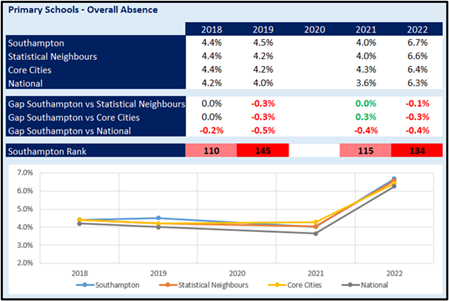 Overall Absence measures the proportion of total possible school sessions that are recorded as an absence code. Absences from school can be authorised or unauthorised by the pupil’s school. In addition to the Overall Absence, a pupil is classed as Persistently Absent if they miss 10% or more of possible sessions. The proportion of pupil enrolments that have missed 10% or more of possible sessions is used to calculate the rate of persistently absent pupils.
Overall Absence measures the proportion of total possible school sessions that are recorded as an absence code. Absences from school can be authorised or unauthorised by the pupil’s school. In addition to the Overall Absence, a pupil is classed as Persistently Absent if they miss 10% or more of possible sessions. The proportion of pupil enrolments that have missed 10% or more of possible sessions is used to calculate the rate of persistently absent pupils.
In response to the Coronavirus pandemic the Department for Education introduced additional absence codes to understand the impact of the pandemic. Due to the introduction and removal of these codes comparing data over multiple years is not recommended.
 Southampton’s Overall Primary Absence for 2021/22 was 6.7%, which is 0.4% higher than the national average (6.3%) and achieved a National rank of 134th of 151 Local Authorities.
Southampton’s Overall Primary Absence for 2021/22 was 6.7%, which is 0.4% higher than the national average (6.3%) and achieved a National rank of 134th of 151 Local Authorities.
Southampton’s Primary School Persistent Absence for 2021/22 was 20.1% (3705 enrolments), which achieved a National rank of 127th of 151 Local Authorities. Southampton’s performance of 20.1% was 2.4% above the National average of 17.7%. In order for Southampton to have matched the National average, 448 fewer pupils were needed to be classified as being Persistently Absent.
Southampton’s Overall Secondary Absence for 2021/22 was 9.9%, which is 0.9% higher than the national average (9.0%) and achieved a National rank of 123rd of 151 Local Authorities.
Southampton’s Secondary School Persistent Absence for 2021/22 was 29.0% (3664 enrolments), achieving a national rank of 99th out of 151 Local Authorities. Southampton’s performance of 29.0% was 1.3% above the national average of 27.7%.
Permanent Exclusions and Suspensions
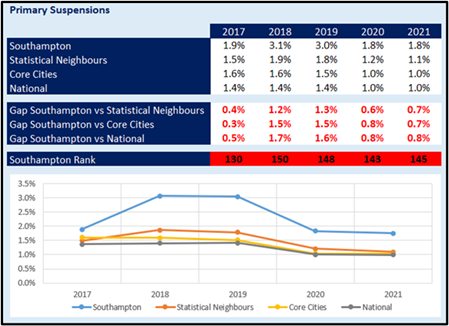 A Permanent Exclusion refers to a pupil who is excluded and who will not come back to that school (unless the exclusion is overturned). Suspensions, previously known as 'fixed period exclusions', refer to when a pupil is excluded from a school for a set period.
A Permanent Exclusion refers to a pupil who is excluded and who will not come back to that school (unless the exclusion is overturned). Suspensions, previously known as 'fixed period exclusions', refer to when a pupil is excluded from a school for a set period.
The Permanent Exclusions and Suspensions covering the 2019/20 academic year includes the start of the pandemic when, from 23 March, school sites were closed for all but those children of critical workers and vulnerable children. Pupils not attending school were educated remotely. Permanent Exclusions and Suspensions were possible throughout the full academic year but comparisons to previous years should be treated with caution.
 Southampton’s Primary schools had 2 Permanent Exclusions in 2020/21, an exclusion rate of 0.01%. The national average exclusion rate was 0.01%, which meant Southampton performance was in line with the national average and achieved a ranking of 109th of 150 Local Authorities. Southampton’s Primary school Suspension rate was 1.75%, a decrease of 0.08% from 1.83% in 2019/20. However, this was 0.76% points above the national average (0.99%) and achieved a ranking of 145th of 150 Local Authorities.
Southampton’s Primary schools had 2 Permanent Exclusions in 2020/21, an exclusion rate of 0.01%. The national average exclusion rate was 0.01%, which meant Southampton performance was in line with the national average and achieved a ranking of 109th of 150 Local Authorities. Southampton’s Primary school Suspension rate was 1.75%, a decrease of 0.08% from 1.83% in 2019/20. However, this was 0.76% points above the national average (0.99%) and achieved a ranking of 145th of 150 Local Authorities.
Southampton’s Secondary schools had 6 Permanent Exclusions during the academic year 2020/21, a rate of 0.05%. This is 0.07% lower than the 0.12% in 2019/20. In 2020/21, Southampton’s performance (0.05%) was also 0.05% below the National average (0.10%) and achieved a ranking of 29th out of 149 Local Authorities. Southampton’s Secondary school Suspension rate in 2020/21 was 5.65%, a decrease of 1.60% from 7.25% in 2019/20. Southampton performance (5.65%) was also 2.83% below the National average (8.48%) for Secondary school Suspensions. Southampton achieved a rank of 33rd of 149 Local Authorities in 2020/21.
Resources section
Throughout the Education Outcomes section reference has been made to Statistical Neighbour and Core City performance. The Statistical Neighbour average consists of 10 Local Authorities (excluding Southampton) that are demographically similar to Southampton. Southampton’s Statistical Neighbours are currently Portsmouth, Sheffield, Peterborough, Plymouth, Derby, Bristol, Coventry, Stoke-On-Trent, Kingston Upon Hull and Salford. The Department for Education Statistical Neighbour benchmarking tool is available below. The Core City average consists of 8 Local Authorities (excluding Southampton) that are large regional cities. Local Authorities that make up the Core City average are Birmingham, Bristol, Leeds, Liverpool, Manchester, Newcastle, Nottingham and Sheffield.
Resources
Early years foundation stage profile
Statistics on early years foundation stage profile assessments including breakdowns by pupil characteristics.
Key stage 1 and phonics screening
Statistics on national curriculum assessments at key stage 1 and phonics screening check results.
Key stage 2
National curriculum assessments and review outcomes at key stage 2, including measures of progress between key stages 1 and 2.
Key stage 4
Statistics on key stage 4 results, including GCSEs.
Key stage 5
Statistics on the attainment of 16 to 19-year-olds in England, including exam results and performance tables.
Absence
Statistics on overall authorised and unauthorised pupil absences by school type, including persistent absentees and pupil characteristics.
Permanent exclusions and suspensions
Statistics on pupils who are excluded from school.
Local Authority Interactive Tool (LAIT)
An interactive spreadsheet for comparing data about children and young people across all local authorities in England.
Children's services statistical neighbour benchmarking tool
The Children’s services statistical neighbour benchmarking tool allows you to select a local authority and display its ‘closest statistical neighbours’ (local authorities with similar characteristics).
Last updated: 26 April 2023